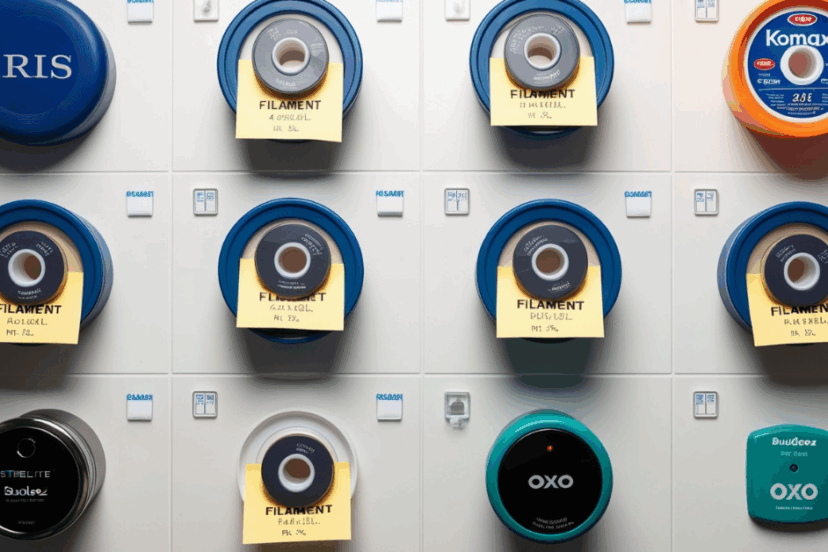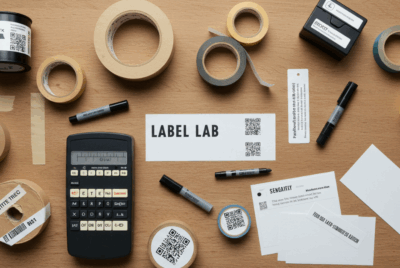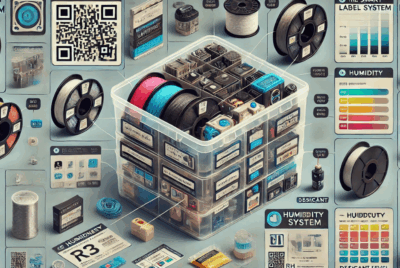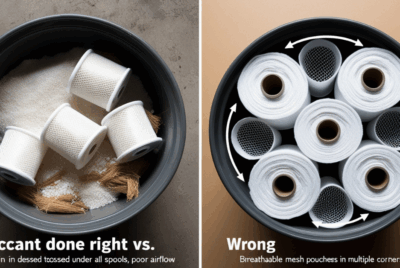Best 3D Filament Storage Containers: What to Look For
1. Your Filament Deserves Better
If you’re still storing your spools in open bins, dusty drawers, or on a wire rack in a humid garage—your 3D prints are probably suffering.
It’s not just about organization.
It’s about preservation.
Let’s look at the best filament storage containers and how to pick one that works for your space, materials, and budget.
2. Why Storage Containers Matter
Filament is moisture-sensitive. Even a small RH (relative humidity) increase can lead to:
- Stringing
- Layer separation
- Nozzle clogs
- Weak or brittle parts
Proper containers keep moisture out, order in, and filament print-ready.
3. What Makes a Filament Container “Good”
A great storage container will:
✅ Seal tightly against air and humidity
✅ Hold multiple spools without damage
✅ Allow you to monitor conditions inside
✅ Fit into your workspace or stack well
✅ Be reusable and durable
It’s not just a box—it’s a vault for your materials.
4. Airtight vs. Non-Airtight Containers
| Feature | Airtight | Non-Airtight |
|---|---|---|
| Moisture protection | ✅ Excellent | ❌ Poor |
| Long-term storage | ✅ Yes | ⚠️ Not recommended |
| Needs desiccant | ✅ Always | ✅ Always |
| Risk of RH fluctuation | ❌ Low | ✅ High |
| Example | IRIS Weathertight Bin | Standard plastic tote |
Verdict: Airtight always wins—especially in humid climates.
5. Key Features to Look For
- 🔒 Rubber gasket seal
- 📦 Fits at least 2–4 spools
- 🌀 Accepts desiccant packs or tubs
- 🔍 Clear panel or labeling area
- 📉 Support for RH tracking (card or sensor)
Optional, but nice:
- 🎯 Spool holders or dividers
- 🧵 Feed-through ports for dry printing
6. Size and Capacity Considerations
Choose based on:
- Number of active spools
- Filament diameter (1.75mm vs. 2.85mm)
- Container height (some bins are too short!)
- Future expansion—can you stack or add more later?
Ideal: One bin for 3–5 spools, unless you’re using a rolling cart or shelf system.
7. Desiccant Compatibility
You want a container that easily fits:
- Loose silica packs
- Color-changing silica cans
- Rechargeable mini dehumidifiers
- Cups or holders for RH cards
💡 Place desiccants in the corners or on the bottom—not touching filament directly.
8. Stackability and Space Efficiency
In small spaces, vertical wins.
Look for:
- Flat lids
- Locking lids that won’t pop open
- Reinforced bases
- Consistent sizing if buying multiples
Modular systems help you build a “filament tower” that doesn’t tip over.
9. Clear vs. Opaque Containers
| Type | Pros | Cons |
|---|---|---|
| Clear | Easy to see contents | Allows in UV light |
| Opaque | Blocks light, more discrete | Harder to ID materials |
If using clear containers, keep them out of direct light or cover with UV-blocking film.
10. Built-in Humidity Monitoring
✅ Humidity cards = low-cost solution
✅ Digital hygrometers = more accurate
✅ Bluetooth sensors = track multiple containers remotely
The more filament you store, the more valuable real-time humidity data becomes.
11. Feed Ports and Dry-Box Functionality
Some containers can double as dry boxes, allowing you to print directly from them.
Look for:
- Pre-drilled or drillable filament feed holes
- Rubber grommets to prevent air leaks
- Smooth spool rotation or rollers inside
Great for daily-use filaments like PLA and PETG.
12. Top Airtight Containers for Filament (Real Brands)
| Brand | Model | Notes |
|---|---|---|
| IRIS USA | Weathertight Box (19 Qt) | Holds 4–5 spools, stackable |
| Oxo | Good Grips POP Container | Stylish, best for 1–2 spools |
| Sterilite | Gasket Box | Great budget option |
| Buddeez | Pet Food Dispenser | Lid flips open for easy access |
| Komax Biokips | XL Locking Container | Highly airtight, BPA-free |
All under \$30 and widely available.
13. Popular Non-Airtight Containers (and Why to Avoid Them)
- Open crates
- Fabric boxes
- Snap-lid totes with no gasket
- Toolboxes with open hinges
These may organize well, but they won’t protect against humidity. Use them only with vacuum-sealed spools inside.
14. Budget-Friendly Storage That Still Works
💡 You can make a great setup with:
- Vacuum bags + silica gel
- Clear bins + added gasket tape
- Upcycled cereal or pet food containers
- Rubber-sealed mason jars (for samples)
It’s not about fancy—it’s about function.
15. Final Thoughts: The Best Container is the One You’ll Actually Use
Whether you buy a dry box or DIY your own airtight bin, what matters most is:
✅ It’s sealed
✅ It’s moisture-controlled
✅ You can maintain it consistently
The best filament container isn’t the most expensive—it’s the one that keeps your spools safe and works for your workflow.
❓FAQs
- Do I need airtight containers if I already vacuum seal filament?
If the vacuum seals are solid, no—but airtight containers offer a second layer of defense and organization. - What size container do I need for 5 spools?
Look for 19–24 quart bins or 10-gallon stackables. Test with your largest spool first! - Can I store filament in a toolbox or drawer system?
Yes, but only if it’s sealed and includes desiccant. Otherwise, it’s just organized exposure. - Do dry boxes replace the need for airtight containers?
Only for active-use spools. Dry boxes aren’t ideal for long-term storage unless fully sealed. - How do I turn a regular bin into a filament storage container?
Add a gasket, drop in silica gel, label the contents, and monitor RH with a card or hygrometer. Simple and effective.




